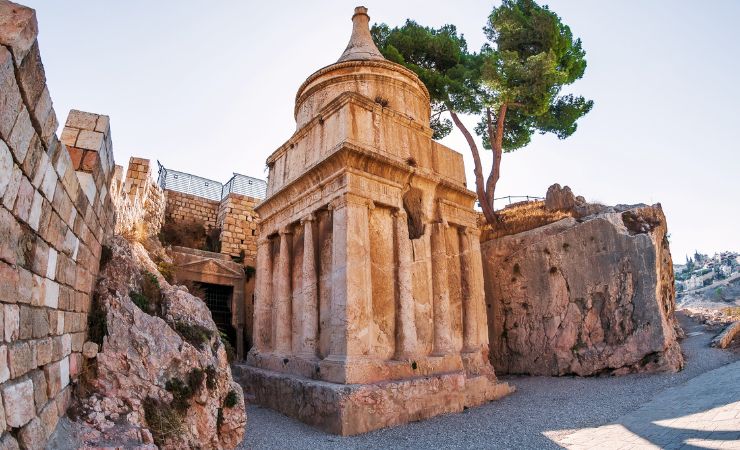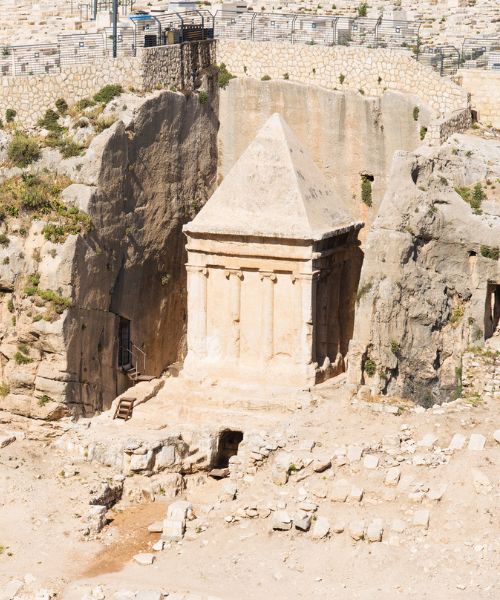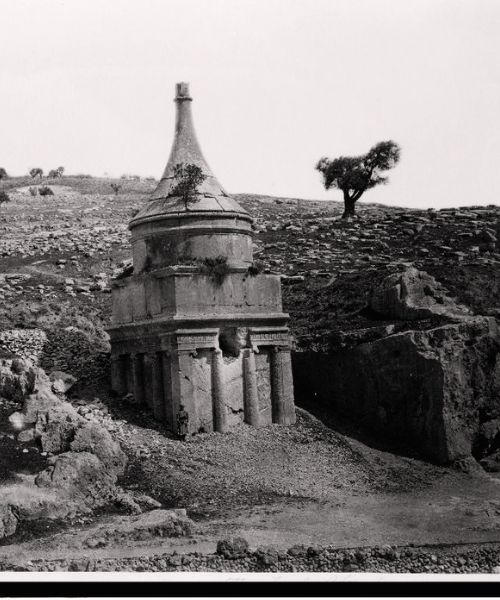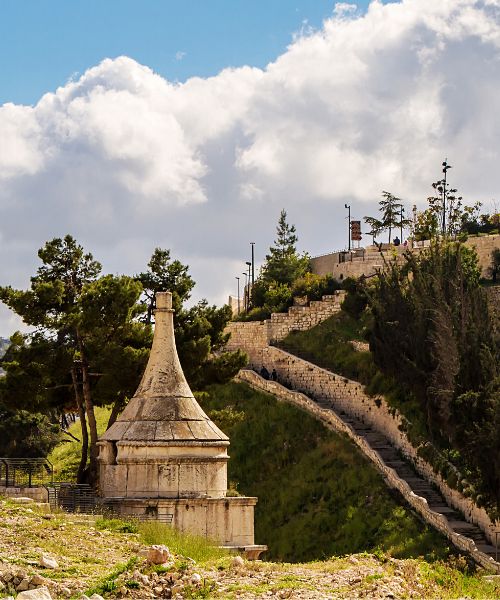The Tomb of Absalom: A Timeless Monument of a Rebel Son?
Introduction
The Tomb of Absalom, also known as Absalom’s Pillar, is an ancient monumental rock-cut tomb with a conical roof located in the Kidron Valley in Jerusalem, a few meters from the Tomb of Zechariah and the Tomb of Benei Hezir. Despite its traditional ascription to Absalom, the rebellious son of King David of Israel (circa 1000 BC), recent scholarship has dated it to the 1st century CE. The monument was cursed and pelted with stones for centuries because of Absalom’s betrayal.

Location
The Tomb of Absalom is situated in the Kidron Valley, also known in the Bible as the Valley of Jehoshaphat1. This valley runs southeast from Jerusalem down to the Judean Desert, eventually leading to the Dead Sea. The tomb is nestled between the Mount of Olives and the Old City Temple Mount
Biblical Context
The Tomb of Absalom is believed to have been constructed during the 1st century CE, during the Second Temple period.
The tomb’s association with Absalom stems from the biblical account of Absalom’s rebellion against his father, King David. The Bible tells us that Absalom was very proud of his long and beautiful hair, which ironically led to his death when it got caught in the branches of a tree while he was trying to escape.
Constructed approximately a millennium after the death of the person it’s named after, the origins and the commissioner of the structure remain uncertain. However, at some point in history, it became linked with the mythical “Pillar of Absalom” referenced in the Old Testament. As per the Book of Samuel (18:18), Absalom set up a monument in his own honor due to the absence of a son to perpetuate his legacy.
Now Absalom in his lifetime had taken and set up for himself the pillar that is in the King’s Valley, for he said, ‘I have no son to keep my name in remembrance.’ He called the pillar after his own name, and it is called Absalom’s monument to this day.
The “Copper Scroll” (a part of the Dead Sea Scrolls, dated to 68 CE) and Flavius Josephus’ Antiquities of the Jews (93 or 94 CE), are both first-century sources that mention the existence of such a monument in Jerusalem. These likely contributed to the connection of the existing structure with Absalom. Simultaneously, a Greek inscription from around the 4th century CE at the entrance to the Tomb, declares it to be “the tomb of Zacharias, the pious martyr and father of John”. These inscriptions, however, were eventually removed.
Some archaeologists, such as Gabriel Barkay, believe that the tomb may actually belong to Herod Agrippa, the last of the Herodian rulers of Judea and Herod’s grandson1.
Architecture and Archaeology at the Tomb of Absalom
The Tomb of Absalom is a striking architectural marvel, standing approximately 20 meters high. The monument stands on a square base and consists of two distinct parts. The lower section is a monolith, hewn out of the rocky slope of the Mount of Olives, while the upper part, rising higher than the original bedrock, is built of neatly cut ashlars.
The lower half of the Tomb: This is a solid, almost perfectly cubical monolithic block, about 6 meters square by 6.4 meters high, surrounded on three sides by passageways which separate it from the vertically cut rock of the Mount of Olives. It is decorated from the outside on each side by pairs of Ionic half-columns, flanked in the corners by quarter-columns and pillars. The four square facades are crowned by a Doric frieze of triglyphs and metopes and an Egyptian cornice.
The upper half of the Tomb: This is an ashlar-built part of the monument consists of three differently-shaped segments: a square base set on top of the Egyptian cornice of the lower part, followed by a round drum crowned by a rope-shaped decoration, which sustains a conical roof with concave sides. The upper part of the monument corresponds to the outline of a classical tholos and is not unlike contemporary Nabatean structures from Petra.
On the inside, the upper part of the monument is mostly hollow, with a small arched entrance on the south side set above the seam area (where the masonry part starts). Inside this entrance, a short staircase leads down to a burial chamber carved out of the solid, lower section. The chamber is 2.4 meters square, with arcosolium graves on two sides and a small burial niche. The tomb was found empty when first researched by archaeologists.



Byzantine Inscriptions
In 2003, a mid-4th-century CE inscription on one of the walls of the monument was discovered. It reads, “This is the tomb of Zachariah, the martyr, the holy priest, the father of John. This suggests that at the time, the monument was considered to be the burial place of the Temple priest Zechariah, father of John the Baptist, who lived 400 or so years earlier than the inscription date. This inscription is part of a secondary usage of this monument during the Byzantine period, where Christian monks commemorated stories from the Christian Bible inside old Jewish tombs in the Kidron Valley.
A second inscription of the same age discovered in 2003 says the monument is “the tomb of Simeon who was a very just man and a very devoted elder and (who was) waiting for the consolation of the people. The words describing Simeon are identical to those from Luke 2:25 as they appear in the Codex Sinaiticus, a 4th-century manuscript of the Christian Bible.
Byzantine Inscriptions
Sources and Additional Reading:
Tomb of Absalom in Wikipedia
Tomb of Absalom In Madain Project
The “Tomb of Absalom”: The Earliest Judeo-Christian Place of Pilgrimage in Jerusalem.
Nearby Sites
- Bnei Hazir Tomb: This tomb, carved into the rocks, was built for the Hezir priestly family, mentioned in the Dead Sea Scrolls as the priests in charge of Yom Kippur ceremonies during the Second Temple period.
- Tomb of the Prophet Zechariah: This is another significant monument located in the Kidron Valley. It is traditionally associated with the prophet Zechariah.
Church of All Nations: Also known as the Basilica of the Agony. This is a Catholic church that enshrines a section of bedrock where Jesus is said to have prayed before his arrest.
Mary’s Tomb: This is a Christian tomb in the Kidron Valley that was believed in the 6th century to be the burial place of Mary, the mother of Jesus.
Lion’s Gate: This is one of the seven open Gates in Jerusalem’s Old City Walls. This gate is located in the eastern wall and leads directly to the Via Dolorosa.



